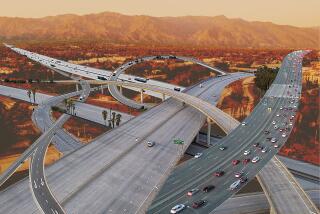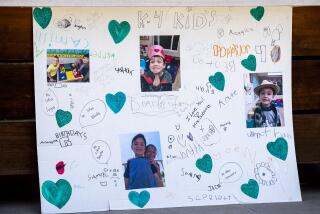The Information Superhighway Helps Map Out the Right Route
In 1910, the Brooklyn Eagle newspaper described driving as âthe last call of the wildâ and the âworldâs most exciting sport.â Back then--before SigAlerts and 10-lane interstates--the long-dead Eagleâs description was not far off.
Before 1920, most roads were little more than dirt paths that turned to sludge in the winter, and what road maps there were pointed out gnarled trees and old bridges as landmarks. How things have changed.
While the basic workings of the internal combustion engine have evolved remarkably little since the turn of the century, the accouterments of getting from here to there have kept pace with technology.
In Southern California, commuters can have up-to-the-minute traffic reports beamed straight to their home computers or even to their pocket pager. Vacationers can plan their entire trip electronically--all the way down to roadside dining and highway lodging. The venerable Thomas Bros. have put their ubiquitous map books on CD-ROM.
Now, even the San Diego Freeway is a part of the celebrated infobahn.
What a difference from the road trips Michigan novelist Edmund G. Love described in the early days of automobility. On a 10-mile stretch between Lapeer and Imlay City, Love was stuck in the mud eight times. On another occasion, he recalled being hopelessly lost on a detour to Owesso--only 20 miles from home.
While modern technology may offer advantages, it is not always cheap. In fact, some of the more sophisticated programs run more than the $290 it cost to buy a Ford Model T in 1924.
*
When Chevy Chase tried to plan the Griswold family getaway to Wally World in the 1983 film âNational Lampoonâs Vacation,â he flipped on the old home computer and fought for space on the screen with his game-playing son.
The trip turned into a disaster.
Ten years later, a slew of computer programs available for under $100 would make the Griswold family trip considerably easier. Companies such as DeLorme and Rand McNally have put together programs that do essentially what Auto Club workers have done for generations.
The programs detail not only directions but point out sights along the way, as well as places to rest for the night and restaurants to sample the local culinary fare.
Two programs tested recently were for planning trips accurately to within a few tenths of a mile--from a quick jaunt between Santa Monica and Arcadia to a longer trip from Chatsworth to Las Vegas.
On the Vegas trip, the DeLorme program estimated the trip to take 4 hours, 58 minutes. It suggested tourist stops along the way at the Gene Autry Western Heritage Museum, the Warner Bros. studios and the Descanso Gardens.
Once in Vegas, the program suggested a long list of accommodations, from an $800 room at the Luxor to a $39 stay at the Motel 6 Las Vegas Tropicana. Half an hour outside of town in Jean, a room can be found at Whiskey Peteâs Hotel and Casino for between $20 and $30.
Whiskey Peteâs doesnât have a fitness center, according to the program, but it does have--not surprisingly--a cocktail lounge.
For the local jaunt, the Rand McNally program estimated 36 minutes of driving time for a 34-mile trip between Santa Monica and Arcadia. It suggested stops along the way at the Westside Pavilion and Santa Monica Place.
A similar program called GeoFinder takes the familiar Thomas Bros. map books into the electronic age. A single CD-ROM contains every map page Thomas Bros. covers in California.
Typing an address takes the user to its precise map page. The user can further manipulate the map on the screen by zooming in and out. The final product can be printed out.
An additional attachment to the program will update current traffic conditions on major routes, making it possible for someone to check the freeways from an office terminal before heading home. (So far, thankfully, motoring with one hand on the steering wheel and the other on a portable laptop is not recommended.)
One feature the Thomas Bros. program does not have is a route finder.
âYou canât do that on GeoFinder,â said Glen Jansma, Thomas Bros. vice president for business development. âEvery market test weâve done in Southern California--where people take driving to heart--is that as soon as you tell someone the right way to go, they will tell you that you are crazy.â
But the whole idea of driving is to be out on the open road, not chained to a computer terminal. Aldous Huxleyâs brave new vision of personal helicopters has yet to materialize, but at least two products give gridlocked drivers instant traffic information to escape tie-ups across Southern California.
If radio traffic reports every six minutes just arenât enough, thereâs now a way to scan the roadways every single minute. Consider Autotalk, a device that attaches to a carâs radio. By typing onto a dash-mounted key pad, drivers can hear a dispatcher constantly updating traffic information about the road theyâre on--or the ones theyâre headed to.
For instance, if a driver only drives in the northern part of Los Angeles County, she might program out reports from all other areas--thereby blocking reports about jackknifed trucks on the northbound Pasadena Freeway while heading west on the Ventura.
*
Another product called Roadirector is nothing more than a pocket pager. But in addition to messages and phone numbers, the Roadirector displays traffic information updated every five minutes.
Like Autotalk, Roadirector can be programmed to deliver only the traffic reports the user wants. Roadirector marketing director Tak Sit said that eventually the company plans to offer a program that will dispatch similar reports to hand-held note pad computers like Appleâs Newton.
Someday--perhaps soon--everyday cars will be outfitted with on-board mapping computers that process information transmitted via satellite. Itâs already happening on test tracks.
So has all this technology tamed the Eagleâs âlast call of the wildâ? Perhaps, though the view from the 405 on a Friday afternoon is far from civilized.
More to Read
Sign up for The Wild
Weâll help you find the best places to hike, bike and run, as well as the perfect silent spots for meditation and yoga.
You may occasionally receive promotional content from the Los Angeles Times.






